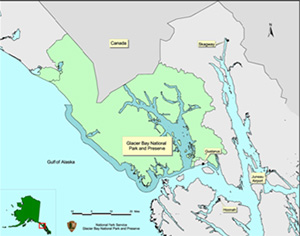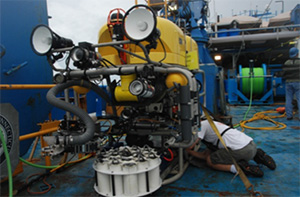

Map of Glacier Bay National Park. Download (jpg, 29 KB).
Glacier Bay National Park (GBNP) preserves one of the largest units of the national wilderness preservation system, encompassing more than 2.7 million acres of glacially influenced marine, terrestrial, and freshwater ecosystems. GBNP protects many unique deepwater fjords - long, narrow, deep inlets of the sea between glacially cut, steep-sided cliffs. These fjords form amazing natural observatories for a diversity of marine habitats.
While the park is internationally recognized as a refuge for many species of marine mammals and seabirds, what lives in the deep waters of these pristine fjords is still largely unknown. Over the years, scientists have determined the presence of cold-water corals, including gorgonians and sea pens, in the waters of the GBNP. They believe there is potential for more deepwater species and extensive coral ecosystems to be found.
Just like tropical coral reefs, cold-water corals create important habitats that support a diverse array of life, representing an essential component to the overall marine diversity within the GBNP. GBNP has been protected for over 90 years, so scientists believe the discovery of cold-water corals in this area can provide high-quality baseline data on the health and ecology of this region.
The primary interest in discovering these ecosystems within GBNP is the potential for their protection within the park boundaries, as well as their historic protection from commercial fisheries.
From March 17-30, 2016, explorers will focus on the central and east and west arms of GBNP and the unexplored remote fjords facing the outer Gulf of Alaska within the boundaries of the park. Scientists will thoroughly explore and map a variety of habitats, carefully and selectively collect samples, as well as examine the genetics of previously collected coral samples.
Goals for this expedition are:

ROV Kraken II showing sampler designed for coral collection. Download (jpg, 36 KB).
During this expedition, explores will be aboard the 177-foot R/V Norseman II .
Tools for data collection will include:
The park’s ability to protect its marine ecosystems depends on continually increasing understanding of marine ecosystem components and processes, and their status and trends. Research and monitoring of these habitat-forming organisms and the ecosystems within the fjord environments produce valuable baseline information useful in measuring environmental change over time both within and beyond the park (Glacier Bay National Park Reserve Foundation Statement, 2010)